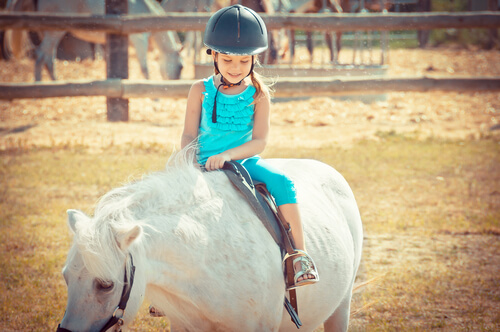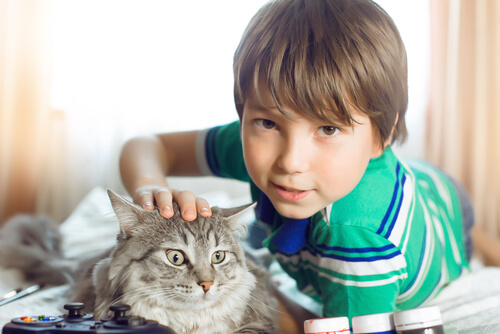How Therapy Animals Can Help Children

Assisted therapy with animals uses different animals for many different rehabilitation reasons. While they can also help adults, therapy animals are especially helpful for children.
Benefits of therapy animals for children
Medical science has advanced and, fortunately, has recognized the positive impact of animal therapy on children’s health. Currently, therapy animals are used in many different exercises with different purposes. Therapists aim to stimulate a specific thing, depending on the species they use and the type of interaction.
You can’t really specify benefits or outcomes in the field of animal therapy. Every child should have a professional that makes a specific treatment plan for him or her.
However, we’ll show you the main benefits that different types of therapy animals most commonly bring to children.
Assisted therapy with dogs
Dogs are probably the most versatile therapy animals that we know of. Their intelligence, sensitivity and devotion to human beings make them very helpful in different rehabilitation contexts.
On the one hand, guide dogs help children with complete or partial vision loss have a better quality of life. With their help, these children can move freely and gain back independence. This freedom is very important as they become adults. They can also be more active and have a healthy social life.
As animal therapy becomes increasingly more used, dogs are also becoming allies of learning. This seeks to use dogs to help with cognitive, emotional, and social skills in children with certain conditions. For example, they help those with mental delays, Autism Spectrum Disorder, or Down syndrome.
It’s also important to mention the sensitive role therapy dogs play with elderly patients and those with serious or terminal diseases. Many hospitals and senior centers have dog-assisted therapies to make a more positive environment. Also, they make the overall mood better and help speed up the patient’s recovery.
Horse therapy and its multiple benefits
Nowadays, horse therapy is the most recognized activity among the various types of animal therapies. Horses can be a “complete tool” in the rehabilitation of children and teens. They can experience cognitive, social, emotional, and neuromuscular achievements.

In fact, horses have been recognized as therapy animals since Ancient Greece. They help people who are recovering from accidents. In addition, horses help control symptoms of both physical and mental diseases.
Horse therapy has also played a central role in pain relief of degenerative diseases. For example, they help with arthritis, osteoarthritis, among others. They’re one of the most popular choices for therapy animals.
Currently, many different types of therapies use therapy animals.
Lizards as therapy animals
Many children adopt iguanas and small lizards as exotic pets. However, their positive impact on health has been studied and used in animal therapy.
Even though they might look scary, these reptiles are very helpful in boosting cognitive and social skills in children.
Iguanas and lizards also have a great advantage over dogs and horses. They take up less space and require simpler care. In addition, since they don’t have hair, they’re great therapy animals for people with allergies.
Small rodent therapy
Children are often attracted to the gentle and delicate aspect of small rodents. These are hamsters, rabbits, and guinea pigs.
These are animals that many aren’t afraid of because they’re so small and gentle. They’re also easy to take care of and they adapt to small environments. In addition, they make an excellent first pet for children.
Zootherapy specialists explain that small rodents help children with autism benefit socially and emotionally.

Cats as therapy animals
One thing to take into account is the positive aspect of therapy cats for elderly adults. Contact with cats can stimulate cognitive capacity and memory.
Currently, lots of research is being conducted on the benefits of animal therapy to discover how this type of treatment can benefit more children in their learning and social skills.
Therapy animals receive the proper training and care they need to help people with their conditions. Assisted therapy is designed to promote a positive experience for both the patient and the animal. Together, the animal and patient can learn and grow together.
All cited sources were thoroughly reviewed by our team to ensure their quality, reliability, currency, and validity. The bibliography of this article was considered reliable and of academic or scientific accuracy.
- Abellán, R. M. (2008). La terapia asistida por animales: una nueva perspectiva y línea de investigación en la atención a la diversidad. Indivisa. Boletín de estudios e investigación, (9), 117-143. https://www.redalyc.org/pdf/771/77100909.pdf
- Martínez, C. A. C. (2013). Terapia asistida con animales. Efectos positivos en la salud humana. Journal of Agriculture and Animal Sciences, 1(2). http://repository.lasallista.edu.co:8080/ojs/index.php/jals/article/view/379
- Oropesa Roblejo, P., García Wilson, I., Puente Saní, V., & Matute Gaínza, Y. (2009). Terapia asistida con animales como fuente de recurso en el tratamiento rehabilitador. Medisan, 13(6), 0-0. http://scielo.sld.cu/scielo.php?script=sci_arttext&pid=S1029-30192009000600015
- SAN JOAQUÍN, M. Z. (2002). Terapia asistida por animales de compañía. Bienestar para el ser humano. Temas de hoy, 143-149. http://patastherapeutas.org/wp-content/uploads/2015/07/TAA_e_bem-estar_humano.pdf
- Zabala Goicoechea, Lucía. (2017). La terapia asistida con animales en niños y niñas con autismo. Trabajo de Fin de Grado. Universidad de la Rioja. https://biblioteca.unirioja.es/tfe_e/TFE002423.pdf
This text is provided for informational purposes only and does not replace consultation with a professional. If in doubt, consult your specialist.
